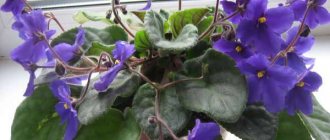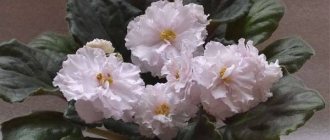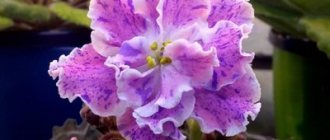Breeders and amateur flower growers who collect Saintpaulias in their home collections, for easier orientation in the incredible variety of varieties and hybrids of these magnificent plants, combine violets into rather conventional groups according to the presence of any common word in the name.
This is the group of varieties "Romance" . Its representatives are gentle and beautiful, like these lyrical musical works, and their images are imprinted in the memory for a long time, like the wonderful melodies of romances. The rules for keeping violets from the “romance” group in home collections almost completely coincide with standard conditions, only some varieties require some privileges . But even beginners can cope with these nuances when studying the advice of experienced flower growers.
Like all Saintpaulias, violet varieties SK-Romance, Midnight Romance, Cher Romance, Sizlin Romance, Silver Romance, Autumn Romance belong to the Saintpaulia genus (Gesneriev family).
Among the most popular “romance” varieties are the works of domestic breeders and the success of foreign breeding schools.
SK-Romance
Domestic selection variety. Author - A. Kuznetsov (2012) . You can see a photo of the SK-Romans violet below.
Description
Violet belongs to the type of semi-miniatures . A small rosette is not very symmetrically formed, with a broken outline, weak fullness and a chaotic scattering of leaves due to their long petioles.
The leaf blades are round in shape with a slightly pointed tip and wavy serration, have a fluffy surface and a dark green tint. A distinctive feature of the variety is the presence of two stipules at the bottom of each leaf.
Saintpaulia refers to varieties with early flowering , but a long blooming process.
The buds are formed on high peduncles, open with a semi-double “wasp”-type corolla - they consist of scattered narrow petals and unopened tubes.
The flowers are a deep shade of pink that fades to a darker shade in the center.
INTERESTING! Among flower growers, the SK-Romans violet is considered an extraordinary variety, popular among lovers of the exotic structure of the flower and dark foliage.
The nuances of keeping indoor culture
The variety is not particularly picky and is suitable for growing in beginners’ collections. The small size of the violet makes caring for the plant easier.
When forming a rosette, you should pay attention to the desire of some specimens to curl the leaves down towards the pot - to create the correct contour, it is advisable to use a corset.
Reviews
Valentina Sergeevna. “The SK-Romance variety is specific, but this is exactly what I love: without flowers it’s a very cute dark fluffy one, with flowers it looks like a flock of circling insects. The buds on the high legs are a little disheveled, but overall the bush looks like a cute, defenseless baby.”
Nikolai Pavlovich. “I tried to grow the SK-Romans violet from a leaf, but there was not enough exposure - the leaf took root very slowly. On occasion, I bought an adult bush of this variety in buds, and again I continue to wait - several peduncles appeared on each leaf petiole, but they take an insanely long time to develop.”
What is the name of violet pink, blue, purple and others
Pink violets are popular plants among gardeners and are grown almost everywhere. But few people know that the plant originally had another name - Saintpaulia, or Uzumbara violet. So it is named after the discoverer of this species, the French naturalist Saint-Paul, and it became Uzumbarian due to the area in which it grows in the wild.
Saintpaulia color scheme
In its natural habitat, the crop does not differ in any special appearance: the buds are not as bright as those of their decorative counterparts, and the leaves are less lush and of a different shape. A wide variety of colors was achieved through selective means. The violet with red flowers was first bred in 1898, with double flowers in 1939, with white flowers in 1940, and only in 1942 was it possible to create a hybrid with pink flowers. This event was so significant for botanists that the resulting hybrid was named Tommy Lowe in honor of the creator T. Louise Auden.
Midnight romance
Varietal Saintpaulia is a successful development of a foreign breeding school, known since 1985 . The creator of the retro variety is Paul Sorano.
Description
Violet Midnight Romance - Midnight Romance (Sorano) is classified according to the standard type. The variety produces a symmetrical, full rosette with neatly arranged leaves.
A distinctive feature is the pronounced variegated color. The leaf plates of a thick green color are edged with a white ribbon, connected to the main color with a speckled transition.
Depending on the growing conditions, the white color may fill the entire leaf or disappear completely . The leaves have the shape of elongated hearts and a glossy surface structure.
Violet blooms in a cap type, forming a large number of buds . The flowers consist of several layers of wavy petals, due to which the terry effect is achieved. The large corollas have a deep blue color with a cobalt tint, which is emphasized by a white edge stripe.
The nuances of keeping indoor culture
The conditions for keeping this violet do not differ from the generally accepted ones, however, there are some features:
- you should take a responsible approach to observing the watering regime, do not flood the violet and do not get water on the leaves;
- it is necessary to monitor the level of illumination; it is best to place Saintpaulia on shelves inside the room;
- if white spotting is severe, you can increase the nitrogen content in the fertilizer for greater chlorophyll formation;
- For leaf spot to appear, it is necessary to create coolness and reduce illumination.
Features of development
A distinctive characteristic of the variety is its requirement for lighting conditions - violet prefers a reduced level of light activity.
IMPORTANT! In bright light, active growth of leaves can occur, which leads to clogging of the central part of the outlet. In this case, to form a proper bush, thinning removal of some leaves will be required.
The color intensity of the leaves and corollas also depends on the brightness of the light: the brighter the lighting, the juicier the overall tone of the violet.
Saintpaulia reacts very sensitively to heavy watering : if moisture stagnates in a flowerpot in cool conditions, botrytis (gray rot) can immediately develop, leading to the death of the plant. The same rot is formed when drops fall on the above-ground parts of the violet.
Reviews
Anastasia Pavlovna. “I suffered with my Midnight Romance bush.” For a long time I had it almost all white and did not want to paint the leaves with green paint. Beginner tip: To reduce the white color on the leaf blades, feed your variegates nitrogen and give them a little more light.”
Mikhail Petrovich. “I have been growing violets of the Midnight Romance variety for many years. I like its frequent flowering, the combination of variegated foliage with cobalt flowers, as well as the ability to adjust the color of the leaves by changing conditions.”
Glamorous violet dessert
Exquisite color, elegant shapes, delicate taste and aroma attract not only flower growers and pharmacists to violets, since violets are rich in healing properties, but also cooks.
Violet desserts are especially popular all over the world. Experts in the field of floral cooking claim that flowers not only make dishes healthy, but also have healing properties .
The violet is the emblem of Toulouse , the city where the tradition of violet delicacies originated. Now La Violette de Toulouse is a registered trademark that can be found on various products (sweets, perfume, liqueur, etc.)
Active ingredients in violet: saponins, mucilage, flavonoids, vitamin C and salicylic acid. Their action is complemented by tannins, bitterness and some other substances.
Candied violets (violettes de Toulouse) are a popular French dessert. Candied violets, like other candied flowers such as tulips, are considered one of the best edible, beautiful and delicious ways to decorate desserts.
for lovers to invite their girlfriends to a violet dessert . After all, back in the Middle Ages, violet was considered a flower of flirtation and seduction.
Fragrant violet is perfect for desserts and drinks. Other varieties of violets are not edible. These flowers give dishes a certain taste and can decorate vegetable and fruit salads. You can use the whole flower and decorate the dish just before serving. Violet jelly, fragrant and tender, is prepared from the petals.
You can make many delicious things from violets! Such as: biscuits with violet extracts, bread with violets, violet jam ( it takes 7600 violet flowers to make 1 kg of jam ), violet liqueurs, violet syrup, sweets (Empress Sissi’s favorite sweets, by the way!) and lollipops, tea, cocktails and candied violet petals. Forest violet goes perfectly with soft cheeses
Currently, all the most famous confectioneries in the world, from Paris and London to Sydney and Tokyo, purchase candied violets from Toulouse to decorate cakes and ice cream.
Cher romance
A retro variety of foreign selection, created by flower growers of the world famous Sorano school in 1987.
Description
“large standard” type . The plant forms an even, neat rosette, but has a slight tendency to lengthen leaf petioles if care conditions are violated.
Heart-shaped leaves with wavy serrations are colored in a tone of lush green, and the underside acquires a silvery tint .
Violet Sheer Romance (S. Sorano) abundantly forms flower stalks with large, showy buds . The corollas are classified as single or semi-double type due to the small number of corrugated petals.
The flowers are always painted in an even tone of deep pink, highlighted by a white fringe.
A small disadvantage of the variety is weak peduncles , due to which heavy corollas can lie on the leaves of the rosette.
The nuances of keeping indoor culture
Saintpaulia can be easily grown by gardeners with any experience, as it does not have any special care requirements.
You just need to monitor the winter maintenance of violets:
- do not keep it on cold windowsills not protected by stands;
- do not allow moisture to stagnate in the flowerpot, which can lead to the formation of rot on the roots;
- It is recommended to water the plant in the first half of the day to dry it out.
The Cher Romance violet, when kept in a fairly cool room during the flowering period, colors the white border of the petals with an additional green ribbon of bright filling.
ADVICE! If you need to add decorativeness before an exhibition, the violet should be placed in a cool place - a green stripe will also appear on the flowers.
Reviews
Nina Vasilievna. “Saintpaulia “Cher Romance” is an old variety, proven over the years and numerous competitions. Forms a compact rosette in an exhibition version, against which pink buds with a white-green edge stand out effectively. Incomparable variety!
Vasily Fedorovich. “Old varieties do not always leave collections and exhibitions. An example is the Cher Romance violet. It was developed a long time ago, but is still popular.”
Reviews
Natalya Andreevna. “ I want to share my joy - I have restored the B. M. Makuni variety “Tatyana’s Day” to the collection. I dreamed about it for a very long time; my grandmother grew up with such beauty. Finally received a leaf from the variety at the exhibition. Five babies appeared on the cuttings, growing relatively quickly. I’m looking forward to the magnificent snow-white blooms.”
Oleg Yuryevich. “ My collection is based on the masterpieces of old selection, since modern violet growers cannot yet offer anything better. And it started with the Tatyana’s Day variety, my favorite. I fall into ecstasy when the snow-white caps with a slight haze of lilac glow at the center open.”
Sislin's romance
Another success of a foreign selection school. Author - Paul Sorano, 2008.
Description
In terms of the size of the rosette, the violet Sizzlin' Romance (LLG/P.Sorano) belongs to the large standard . The variety forms a rosette with an even contour, but somewhat loose due to the elongated leaf petioles.
The oval leaf plates of large sizes have a dark green tint and a smooth surface. The reverse side of the sheet has a reddish backlight.
Violet blooms as a bouquet . Each elongated peduncle supports more than 10 - 15 buds.
The corollas are medium-sized, semi-double filled, painted with a burgundy-coral color. Each wavy petal is decorated along the contour with dark sparkles of burgundy spray.
The nuances of keeping indoor culture
The variety is not demanding on maintenance conditions . But for the active formation of peduncles, the violet should be illuminated with fluorescent lamps, and for this it is better to keep the plants on racks or shelves.
When violets are kept on window sills, fading occurs much more actively.
To preserve the decorative appearance of flowers for a longer time, it is better to move the plants to a rack.
CAREFULLY! A feature of the “Sislin Romans” variety is the strong change in the color of the corollas to a brick shade as the age of the buds increases.
Reviews
Stella. “I purchased the variety “Sislin Romance” at the exhibition - I really liked the shiny fantasy flowers on the flowers. But the buds fade a lot, and this is a big minus. After the third flowering, I gave the violet to a friend; she was not bothered by the brick color of the flowers.”
Polina Andreevna. “I absolutely love the violet variety “Sislin Romance.” It blooms so profusely and its colors are simply divine. The color changes a little towards the end of flowering, but this is even interesting - there are many shades of burgundy on one plant at the same time.”
Syrup Botanika Blackcurrant
Flavored sugar syrup Botanika "Blackcurrant" for the catering industry: restaurants, cafes, bars, catering and home use. Applicable to hot and cold foods and drinks. The syrup can be used in cooking as a component of creams, sauces and toppings for confectionery, baked goods and desserts, gravy for pancakes and cheesecakes. It is recommended to add to coffee, tea, alcoholic and non-alcoholic cocktails, smoothies, and lemonades.
Characteristics
Ingredients: sugar, water, flavoring, acidity regulator: citric acid
Nutritional value per 100 ml of product: carbohydrates – 84.9 g Energy value per 100 ml of product: 344 kcal / 1428 kJ
Brix: 64-65°Br Recommended dilution: 1:8, dosage for coffee/tea: 10-15 ml per serving
Container: 1 liter glass bottle, dispenser-distributor on the neck Weight with bottle (full): 1.85 kg; height: 35 cm, ∅ 10 cm
Natural product, precipitation and/or opalescence may occur. Shake before use! Storage conditions: store at temperatures from +10°C to +30°C and relative humidity no higher than 75% away from direct sunlight. It is recommended to consume an opened bottle within 2 months, subject to storage conditions.
Silver romance
Violet Silver Romance is a variety of foreign selection.
Description
The violet develops according to the standard type , forming at first a somewhat sparse rosette due to the long petioles of the leaves. As it grows, the rosette becomes collected and filled.
The wavy leaf blades with rounded teeth are distinguished by emerald veining against a background of shiny dark green and a reddish underside.
Saintpaulia blooms with chic large corollas , tinted transitions of pink and cream shades of varying intensities. Each petal is burdened with a fringed edge of a greenish color.
The violet blooms very luxuriantly, with double flowers.
The nuances of keeping indoor culture
The variety does not impose any special requirements on gardeners when creating comfortable conditions for indoor cultivation. It blooms readily and a lot , forms a beautiful rosette.
To preserve the decorative appearance and form many buds, it is enough to follow standard care regimens.
Reviews
Anna Vladimirovna. “I tried to find information about the author of the Silver Romance variety. Some sources point to Sorano's school, others mention Harrison's name. But in the catalogs in English, none of these breeders mention such a variety name. It turns out that the creator of the violet is still unknown.”
Yakov. “The Silver Romance violet amazes with its showy pink-green flowers. I saw it at an exhibition, fell in love, and bought it for my collection. Now I admire it every day.”
Contents in room culture
The principles of classical care are absolutely suitable for violets :
- On the southern windows you need shading, on the northern ones - lighting;
- Watering - dosed, with drying part of the soil from above;
- Feeding - if necessary;
- Lighting - natural, diffuse spectrum;
- Temperature is optimal +20 + 24°C;
- The substrate is rich in nutrition, aerated, permeable. Drainage is required;
- When planting, it is better to choose transshipment.
This variety requires standard care.
Autumn romance
Domestic selection variety. Violet was created by E. Korshunova in 2006.
Description
Saintpaulia forms a not very large, but neat and full rosette of the standard type.
The leaf blades are round in shape with slightly wavy edges and are characterized by bright variegated colors: along the contour of the main dark-colored background, a contrasting pattern with transitions of cream and pinkish shades seems to be embroidered.
The variegated color does not appear immediately - with age it increases in intensity. The reverse side of the leaves is burgundy in color.
Flowering always occurs very vigorously , with the formation of a large number of buds, with long-term preservation of the decorative effect of the flowers.
The semi-double fullness corollas are colored with tints of pink, coral and brick tones.
From flowering to flowering, the buds increase in size.
The nuances of keeping indoor culture
A completely picky variety that can adapt to the conditions of any room, therefore it is recommended as one of the first plants in the collections of beginning violet lovers.
ADVICE! To maintain spectacular variegated colors, violets should be placed in cool rooms and when feeding, do not get carried away with nitrogen fertilizers. Nitrogen promotes the formation of chlorophyll, which means it reduces the light border of the leaf.
Reviews
Sergey. “I really like the varieties of Elena Korshunova - I am collecting a collection of violets from this particular breeder. And the violet EK-Autumn Romance is one of my favorites, since it was with it that my passion for violets began.”
Veronica Andreevna. “I bought the violet “Autumn Romance” at the exhibition, I liked the combination of pinkish-brown buds with variegated foliage. She took care of it according to all the rules, watered it, fed it. But gradually the leaves became completely green, the contrasting light color disappeared. It turned out that she had overfed her with nitrogen fertilizer. Now I’ve canceled the feeding, kept it in a cool place and reduced the lighting - everything is as recommended in the literature.”
A dozen varieties of violets for your window
Pansy, star, bell, bowl, wasp - what do these words have in common? The answer is simple - of course, violet. Her flowers come in this shape. They are also divided according to size, terryness and other external characteristics.
House violet (Saintpaulia ionantha)
alt=”domestic violet” width=”460″ height=”342″ />
photo from almanac.com
If you have not grown violets yet, then you should start with an ordinary indoor Saintpaulia. Outwardly, it is similar to the purple flower that in 1892, during a walk with his bride, was discovered by the military commandant of the Uzambara district of German East Africa, Baron Walter von Saint-Paul. He sent the seeds to his father, who headed the German Dendrological Society. Ulrich von Saint-Paul, in turn, gave them to the botanist Hermann Wendland, who introduced the flower to the world, calling it Saintpaulia in honor of his father and son.
Features of flowering, growth and reproduction
PIK-Byzantium grows well; in 10-11 months you can get an adult . The first flowering occurs around the same time and is immediately abundant. In most cases it blooms with a cap.
The peduncles are strong, quite thick , stretching towards the center of the rosette, with 3 to 5 buds on each. Flowers last a very long time , but this requires appropriate conditions.
It is important to keep the room cool , then the fringe will be brighter and there will be more green color around the edge, and in addition, the duration of flowering will increase.
PIK-Byzantium prefers cool conditions.
Byzantium has no variegation on the leaves and the flowers do not have a chimeric color, so the variety can be propagated by any method that the gardener likes. The best option is a leaf cutting, since the survival rate of peduncles is small, and the number of stepsons is quite scarce.
Choosing a pot
No matter how you feel about plastic, it is the best material for violets when it comes to flower pots. The fact is that the evaporation of water in such containers does not occur so quickly, therefore, the frequency of watering is reduced and the life of the plant increases.
Plastic pot for violets
Clay pots can destroy the plant. An SOS signal for the gardener will be fading leaves or traces reminiscent of the visit of small insects. The reason is the contact of clay and leaves. It is not necessary to replant the flower, save it, and at the same time decorate it, you can use raffia, sisal or coconut fiber.
As for the size, we select the diameter of the pot to be three to three and a half times smaller than the violet. You should not immediately take a large pot, the flower will not be able to master the huge earthen lump.
Young rosettes are initially placed in pots no larger than 5 centimeters in diameter, increasing in size after about six months.
Attention! The violet will not bloom until it fills everything with roots, so there is no need to rush here.
Matron's noctule, hesperis, or night violet
The plant got its name from the Greek word “hesperos”, which means evening. The flowers are fragrant and emit a particularly strong aroma in the evening and at night. Hesperis is a perennial grown as a biennial because in the third year the plants bloom poorly and many die. In the first year, a dense rosette of leaves is formed, in the second year the stem grows up to 80 cm, branched in the upper part, with numerous flowers in cylindrical racemes. The leaves are elongated, fleecy. The flowers are simple and double, purple, lilac, white. Seeds are sown in June - early July, seedlings are planted, and in September they are planted in a permanent place. Plants bloom in June. Biennial plants produce many high-quality seeds that ripen well and self-sow. If it is not limited, then hesperis can take over the entire flower garden. The plant is unpretentious, frost-resistant, loves moist, loose, nutritious soil containing lime, and can withstand partial shade.
|
|
Bearded carnation, or Turkish carnation
A perennial plant, but used as a biennial. Seeds are sown in early July, seedlings appear in 10–12 days, and after a few days they are harvested. At the beginning of August, small dense bushes develop, at which time the plants should be planted in a permanent place. Bearded carnation overwinters better if the plants have developed well after transplantation. The following year in the spring, straight, knotty stems 40–50 cm high appear, ending in a dense corymbose inflorescence consisting of many five-petaled flowers. Flowers of bright pure color: white, pink, copper-red, burgundy or two-tone - with an eye or border. Blooms in June.
|
|
Currently, many forms and varieties are known, there are simple and double varieties. When propagated by seed, the doubleness of the flower is not completely transmitted; usually, only half of the double varieties are obtained from sowing double varieties. To reproduce terry varieties, you need to use green cuttings, which are taken in June from two-year-old plants and rooted in shaded beds with constant moisture.
Turkish carnation is winter-hardy, grows well on loamy or sandy loam soils, in sunny places, but can also withstand partial shade. Blooms for 15–20 days. Propagates well by self-sowing. Cut cloves stand in water for a long time.
Medium bell
This species is a typical biennial. Gives a good cut, lasts a long time in water. The stem is erect, well branched, forms a pyramidal bush, covered with stiff hairs, the leaves in the rosette are oval-lanceolate, the upper ones on the stem are narrow-lanceolate, stem-enclosing. The plant is vigorous, reaching a height of 70–90 cm. The flowers are blue, light blue, pink, white, lilac, large, collected in loose clusters. Blooms in June–July. Seeds are sown in June - early July, by autumn a rosette of leaves is formed, the seedlings dive and are planted in a permanent place in August. Plants bloom in the 2nd year, bloom profusely, form seeds and die. Very rarely, plants produce shoots from the root collar, which overwinter and bloom in the 3rd year, but rather weakly. The bell loves sunny places, protected from the wind, the soil is nutritious, permeable, well-drained; in damp areas in winter the plant will wither away.
|
|
Forget-me-not hybrid
Forget-me-not hybrid
A little piece of blue sky! At the moment of mass flowering, the bush looks like a blue ball. The plant is 25–30 cm high, the leaves are light green, oblong-lanceolate, the inflorescence is a curl with an abundance of small sky-blue flowers. But there are species with white and pink flowers. Seeds are sown in late June–early July in the ground, planted and left until spring. In spring they are planted in flower beds. Tolerates transplantation well in a blooming state. Blooms from mid-May for 3–4 weeks. Forget-me-not reproduces well by self-sowing, I have never sowed it on purpose, and it grows in a variety of places on our site. Forget-me-nots require fertile, moist soil and a slightly shaded area. If there is a lack of moisture, it blooms poorly and produces seeds earlier.
Lunaria, or reviving lunar
The stem is straight, slightly branched, 1 m high, covered with small hairs. The upper leaves are oval, alternate. The lower ones, making up the rosette, are petiolate, opposite, heart-shaped, toothed. The flowers are large, violet-red, collected in a simple panicle. Lunaria has very original fruits, which are round, filmy pods. The partitions in them are transparent, with a pearlescent tint. After the pod valves fall off, the septum is preserved. The dried stems with pods are dried and used for arranging dry bouquets. Lunaria seeds are sown in June and early July.
|
|
Seedlings require careful care, timely thinning, watering and regular loosening. The soil should be light, nutritious, and the place should be sunny. In August, the seedlings are planted in a permanent place, and the plants bloom in June the following year. For the winter, light shelter is needed.











